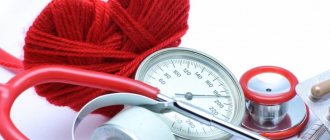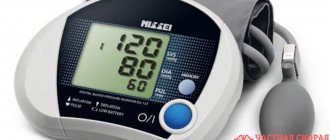Arterial hypertension is the most common cardiovascular pathology, affecting about 40% of the adult European population [1]. Of course, this leads to high demand for antihypertensive drugs, regardless of the season. And although the chief’s task is, first of all, to offer several drug options according to the INN prescribed in the prescription, he also has to explain side effects, dosage, and sometimes answer questions about the features of the mechanism of action. Therefore, we decided to offer our readers a series of articles about the group of antihypertensive drugs and the features of working with requests for them. Let's start with blockers of the renin-angiotensin-aldosterone system.
RAAS: the basics
Before we begin describing the drugs, let’s dive briefly into the intricacies of pharmacology and once again remember what the mechanism of action of the renin-angiotensin-aldosterone system, or RAAS, is.
The RAAS is a complex hormonal-enzymatic system in which almost all organs and tissues of the body are involved, but the key roles in it belong to the liver, kidneys, adrenal glands and lungs.
Alpha-2‑globulin angiotensinogen is constantly synthesized in the liver. At the same time, the kidneys produce the enzyme renin in response to decreased intrarenal pressure, decreased delivery of sodium and chloride, and hypoxia. It enters, like angiotensinogen, into the systemic circulation, where it binds to it to form angiotensin I.
Angiotensin I is a practically inert substance. It does not act on blood vessels and is only a precursor of the active component angiotensin II. In the formation of the latter, along with angiotensin I, angiotensin-converting enzyme (ACE), which is produced in the lungs, is involved.
Angiotensin II is the main link in the RAAS circuit.
It exhibits a powerful vasoconstrictor effect and affects the target organs in which its receptors are located. First of all, we are talking about the endothelium, heart and kidneys. This is why high levels of angiotensin II are associated not only with increased blood pressure, but also with damage to the vascular wall, myocardium, kidneys, and the development of chronic heart and kidney failure.
In addition, angiotensin II causes increased synthesis of the adrenal hormone aldosterone. The latter is involved in the control of blood pressure (BP) by regulating the homeostasis of potassium, sodium and intracellular fluid volume. Under its influence, blood pressure increases and the sensitivity of vascular smooth muscles to vasoconstrictor substances, including angiotensin II, increases.
Thus, the RAAS is directly involved in the drama called “arterial hypertension”, playing one of the main roles in it. Fortunately, it is possible to block this system. This can be done with drugs of two pharmacological groups - angiotensin-converting enzyme inhibitors (ACEIs) and angiotensin II receptor blockers (ARBs, also known as sartans).
Important information
The new generation of anti-hypertension pills can combat high blood pressure much more effectively than outdated medications. Previously, the problem required the prescription of a whole complex of drugs, each of which performed a specific task. New generation products allow the patient not to take a lot of pills. Pressure-lowering substances have become more powerful, and their therapeutic effect has become more pronounced.
Today, it is enough to take one drug that will provide a lasting reduction in blood pressure at home, since one tablet includes a whole range of active ingredients.
The latest generation of medications for hypertension are created in such a way that they are able to act on the patient’s body in many ways, reducing blood pressure quickly and safely. In addition, the latest tools for normalizing this indicator have a number of additional improved properties.
Hypertension causes headaches. This symptom is very unpleasant and does not always go away with medication. Often, medications for high blood pressure cope with their task, lowering this indicator, but the pain syndrome remains. Few people know why promotion can cause headaches. There are many reasons for such symptoms. Doctors identify several factors that provoke discomfort:
- Vascular. Hypertension causes a disturbance in the tone of veins and blood vessels in the brain. In a healthy person, their narrowing and expansion is controlled by a compensatory mechanism at the reflex level. In a hypertensive patient, the arterial walls contract and remain in this state for a long time, so a headache appears, most often felt in the back of the head, which can be accompanied by vomiting and nausea. Medicines that reduce blood pressure do not always cope with the elimination of pain; it is necessary to take additional medications.
- Liquor. In this case, the pain appears from increased pressure over a long period of time. This situation provokes a severe headache, since the cerebral fluid begins to put pressure on the walls of the ventricles of the brain. When symptoms occur, the patient feels pain in the back of the head. If the pressure level remains elevated for a long time, then pain can spread over the entire surface of the head and be accompanied by nausea, weakness, and vomiting. New generations of antihypertensive drugs are not always able to cope with this problem. The danger of this condition is that if you do not start treating a person on time, cerebral edema may develop, the signs of which are severe dizziness and total loss of consciousness.
- Ischemic. Spasm of cerebral vessels, which occurs when blood pressure rises, can provoke the development of oxygen starvation, which is manifested by headaches and other unpleasant symptoms. Vomiting, darkening of the eyes, impaired consciousness and other signs are added. Modern drugs for the treatment of hypertension can cope with this situation and relieve its consequences.
- Neuralgic. High arterial parameters increase the pressure inside the skull, which can greatly irritate the nerve endings, causing pain that shoots and radiates to other parts of the body (usually in the temples or eyes).
If the disease is not treated, then over time the pain in the head will become painful and constant. Hypertensive patients always need medications that lower blood pressure; they must be taken daily, otherwise complications (heart attack, stroke, TIA) cannot be avoided.
The first class of drugs is ACE inhibitors.
Drugs of this group became one of the first classes of drugs that effectively reduce the activity of the RAAS; their development began in the 60s of the last century [2]. Today they are included in the category of so-called “life-saving drugs” due to their proven ability to improve the prognosis of a number of cardiovascular and renal diseases [2].
ACE inhibitors: mechanism of action and effect
ACE inhibitors reduce the level of circulating angiotensin II by blocking the angiotensin-converting enzyme, which causes a complex pharmacological effect:
- antihypertensive;
- cardioprotective;
- angioprotective;
- antiatherosclerotic;
- anti-inflammatory.
When taking drugs from the ACE inhibitor group, carbohydrate metabolism also improves: tissue sensitivity to insulin increases and glucose metabolism improves.
Indications and properties
The spectrum of activity of ACE inhibitors allows their use in arterial hypertension, coronary heart disease, chronic heart failure, nephropathies and acute myocardial infarction [3].
ACE inhibitors belong to the group of antihypertensive drugs that specifically lower blood pressure and slow the progression of heart failure, which determines their widespread use in cardiology. Data from a review of 158,998 patients with hypertension showed that taking ACE inhibitors reduces mortality from all of the above causes. This is a significant advantage of ACE inhibitor drugs, including compared to angiotensin II blockers [4].
However, ACE inhibitors are still not able to completely prevent the conversion of angiotensin I to angiotensin II, since there are a number of other enzymes that successfully “replace” ACE. This is exactly how the enzymes chymase, elastase and cathepsin G work, for example [5]. When using ACE inhibitors, these substances are compensatory activated, and the blockade of the RAAS becomes incomplete. This is a significant drawback of ACE inhibitors.
What should I warn the client about?
Important!
During the consultation, it is appropriate to emphasize that drugs that block the activity of the RAAS - ACEIs and ARBs - with constant use, along with an antihypertensive effect, protect the heart and blood vessels, significantly reducing the incidence of cardiovascular accidents. This small note can serve as a convincing argument in favor of regular and disciplined use of such drugs, according to the instructions and recommendations of the doctor.
Angiotensin-converting enzyme inhibitors in cardiological practice
AND
Angiotensin-converting enzyme inhibitors (ACEIs) have been used in clinical practice since 1975 and have now become one of the most commonly used groups of drugs for the treatment of arterial hypertension (AH) and heart failure (HF). In the pathogenesis of these conditions, the activation of two neurohumoral systems of the body: renin-angiotensin-aldosterone (RAAS) and sympathoadrenal (SAS) plays an important role.
The activation process is caused by such unfavorable factors as a decrease in cardiac output, ischemia of a vital organ, loss of sodium and water, a significant change in pH, etc. As a result, the formation of a biologically active substance, angiotensin II, occurs, which is a powerful vasoconstrictor, stimulates the release of aldosterone, and can increase the activity of the SAS (stimulate the release of norepinephrine). Norepinephrine, in turn, can activate the RAAS (stimulates renin synthesis). Ultimately, an increase in the activity of these two body systems, causing powerful vasoconstriction, an increase in heart rate, cardiac output, maintains circulatory function at an optimal level, and maintains homeostasis of the body. Normally, the activation of the body’s pressor systems (RAAS and SAS) is “opposed” by the action of the depressor system (kallikrein-kinin: the key link is bradykinin), causing systemic vasodilation. However, with prolonged action of various pathological factors described above, normal regulation is disrupted and the effects of pressor systems predominate.
ACE inhibitors inhibit the effects of pressor systems and at the same time are activators of depressor systems.
The main effects of ACE inhibitors are due to the blockade of angiotensin-converting enzyme (Fig. 1): elimination of the vasopressor, antidiuretic and antinatriuretic effects of angiotensin II, enhancement of the vasodilator, diuretic and natriuretic effects of bradykinin and other endogenous vasodilators (prostaglandins J2 and E2, natriuretic peptide, endothelial relaxation factor), and also mediated by blockade of SAS activity by inhibiting the synthesis of norepinephrine. In the mid-80s, local hormonal systems (primarily the RAAS) were identified in various organs and tissues of the body. Activation of tissue RAAS occurs parallel to plasma (circulating), but the action of these systems differs. Plasma RAAS is activated quickly, but has short-term effects (Fig. 2). The activity of tissue RAAS increases gradually, but persists for a long time. Angiotensin II synthesized in the myocardium activates proto-oncogenes and stimulates hypertrophy and fibrosis of muscle fibers. In addition, it activates the local synthesis of norepinephrine. Similar changes are observed in the smooth muscles of peripheral vessels and lead to its hypertrophy (Fig. 2).
Rice. 1. Neurohumoral interactions: renin-angiotensin-aldosterone, sympathoadrenal and kallikrein-kinin systems
Rice. 2. Systemic and local effects of the renin-angiotensin-aldosterone system
V. Dzau identifies the following
cardiovascular effects of ACEIs:
– systemic arterial vasodilation (reduction of afterload on the left ventricle) without the development of reflex tachycardia;
– venous vasodilation (increased capacity of the venous system, decreased preload);
– prevention of ventricular dilatation (cardioprotection);
– reverse development of ventricular hypertrophy (cardioprotection) and the walls of arteries and arterioles;
– coronary vasodilation;
– suppression of reperfusion ventricular arrhythmias (cardioprotection);
– preventing the development of tolerance to nitrates and potentiating the vasodilating effect of nitrates;
– reduction of sodium and water retention, increase in potassium content.
The first clinical trials of captopril (since 1975) showed high effectiveness in hypertension, including those resistant to other treatment methods. The commercial success of captopril has stimulated the efforts of other companies to find new ACE inhibitors. In 1980, enalapril was synthesized, a next-generation ACE inhibitor characterized by prolonged action. Currently, the clinical use of more than 10 drugs from this group from different manufacturers is approved: enalapril, ramipril, lisinopril
, cilazapril, quinapril, benazepril, perindopril, etc. Along with the properties characteristic of captopril, they have distinctive features. Most of them are characterized by a prolonged effect, higher ACE inhibitory activity, and different pharmacokinetic properties. However, the pharmacodynamic effects of these drugs are similar to each other.
Classification of ACE inhibitors
The classification (there is no generally accepted one) is based on the chemical structure of the part of the molecule that binds to the angiotensin-converting enzyme. The drugs are divided into 3 groups:
– ACE inhibitors containing a sulfhydryl group (captopril);
– ACE inhibitors containing a carboxyl group or carboxyalkyl dipeptides (lisinopril, enalapril, ramipril, perindopril, cilazapril, benazepril, quinapril, trandolapril, spirapril);
– ACE inhibitors containing a phosphoryl group (fosinopril).
Some features of the pharmacokinetics of ACE inhibitors are of real clinical importance: bioavailability, biotransformation (the drug acts independently, i.e., is it an active substance or a prodrug that is converted into active metabolites in the body), elimination pathways and the duration of inhibition of the activity of the angiotensin-converting enzyme.
Captopril
acts as an active drug, bioavailability is 60%, is rapidly absorbed, but its absorption decreases by 30–40% when taken simultaneously with food, so it should be taken on an empty stomach, 1–1.5 hours before meals. Maximum blood concentration occurs 1 hour after oral administration. The activity of captopril (that is, the substance itself) makes it possible to use it as an “ambulance” drug, in particular, to relieve hypertensive crises when taken sublingually. The effect is observed after 15–20 minutes. Captopril has a short plasma half-life (2 hours), therefore it requires 3-4 doses per day and is excreted mainly in the urine.
All carboxyalkyl dipeptides are superior to captopril in terms of duration of action, as they have a longer half-life and are therefore used 1-2 times a day. They bind less to food proteins, therefore, they can be taken regardless of food. All carboxyalkyl dipeptides with the exception of lisinopril are prodrugs, i.e. the formation of active metabolites requires biotransformation of these drugs in the liver. It follows that these drugs must be used with caution in persons with liver failure, and also that they cannot be used as first aid. The main route of elimination of almost all ACE inhibitors, as well as their active and inactive metabolites, is renal excretion. Therefore, in patients with obvious or hidden renal failure, especially in elderly patients, the dose of ACE inhibitors should be reduced. Before starting therapy and during the first week of treatment with ACE inhibitors, it is advisable to monitor not only the creatinine level, but also the glomerular filtration rate (Rehberg test). In addition, it is necessary to prevent the development of hypotension (blood pressure less than 100/60 mm Hg), and not to prescribe other antihypertensive drugs (in particular, diuretics, etc.) at the same time.
Unlike most ACE inhibitors, new drugs - spirapril, fosinopril, trandolapril - are predominantly inactivated by the liver and excreted in bile through the intestines. Consequently, they are very promising drugs for the treatment of elderly and senile people, since this group of patients often has obvious or hidden renal failure.
Enalapril
– “prodrug”, in the liver it turns into the active substance – enalaprilat. Bioavailability – 40%, does not change with food intake. The maximum concentration of enalaprilat is after 2–4 hours, the half-life is 11 hours. Damage to the liver or kidneys increases the onset time and duration of action.
Perindopril
. When taken orally, the drug is rapidly absorbed. Bioavailability – 65–70%. Eating slows down the metabolism of perindopril. The active form is perindoprilat, its maximum concentration in plasma is reached 3-4 hours after taking the drug, and is excreted from the body through the kidneys.
Cilazapril
. Simultaneous administration of the drug with food slightly slows down absorption. Bioavailability – 45%. In the liver, cilazapril is metabolized into the active form, cilazaprilat. Excreted by the kidneys, the half-life is 7.5 hours.
Lisinopril
. Its outstanding pharmacokinetic features are its very low lipid solubility, lack of metabolism in the body (due to low lipophilicity) and urinary excretion. Bioavailability is 30–50% and, most likely, it is not affected by food intake. Peak concentrations in the blood are observed 6 hours after taking the drug. The half-life is 12.5 hours.
Quinapril=quinapril
is quickly absorbed from the gastrointestinal tract, and food intake does not affect absorption. In the liver, the drug is hydrolyzed into quinaprilate. The peak concentration of quinaprilat in the blood is recorded 2 hours after oral administration. Excreted through the kidneys.
Benazepril
. Bioavailability – 17%. In the liver it is converted to benazeprilat. The half-life is 11 hours. Excreted by the kidneys.
Ramipril
. Concomitant food intake does not affect the absorption of the drug. In the liver, it is converted to ramiprilat, which is excreted mainly by the kidneys with a clearance of 80–130 ml/min. Partially excreted in feces.
Spirapril
in the liver it is hydrolyzed into spiraprilat and is excreted mainly in bile.
Trandolapril
in the liver it is converted into the active form - trandolaprilat, excreted mainly in bile.
Fosinopril
when taken orally, it is slowly absorbed, the bioavailability is 36% and food intake reduces it to 20%, it is a “prodrug”, and is metabolized in the liver into fosinoprilat, which is excreted almost uniformly into the urine and bile. However, in the presence of renal failure, fosinopril is virtually completely eliminated through the gastrointestinal tract, which almost completely removes restrictions on its use in patients with impaired renal function.
Side effects of ACE inhibitors
ACEIs have relatively few side effects. The main ones include: hypotension, hyperkalemia, increased creatinine levels, dry cough, allergic reactions. Hypotension often develops during combination therapy with the use of diuretics, slow calcium channel blockers, etc. or in patients with blood pressure no more than 110/70 mm Hg, and, as a rule, is dose-dependent. Therefore, the use of small doses of the short-acting ACE inhibitor captopril is recommended at the beginning of treatment. Hyperkalemia usually occurs during additional use of potassium-sparing diuretics, and the use of drugs with extrarenal elimination removes restrictions on the use of ACE inhibitors in patients with renal failure. Dry cough is observed in 9–26% of patients. It is believed that a dry cough develops in response to excessive concentrations of bradykinin in the bronchial mucosa. In the 90s, an increased incidence of cough was discovered in patients with CHF and impaired renal function. In case of severe cough, it is advisable to replace the intake of ACE inhibitors with angiotensin II receptor antagonists.
Side effects of captopril associated with taking high doses (more than 150 mg/day) are usually explained by the presence of a sulfhydryl group and are manifested by proteinuria, skin rashes, impaired taste, and neutropenia.
Contraindications for prescribing ACE inhibitors:
– bilateral renal artery stenosis or stenosis of the artery of a single kidney;
– severe aortic or mitral stenosis, obstructive cardiomyopathy;
– initial hypotension (BP less than 100/60 mm Hg);
– pregnancy, lactation.
Treatment of arterial hypertension with ACE inhibitors
Experience in treating hypertension with various ACE inhibitors shows that a hypotensive effect develops in 50–75% of patients with various forms of hypertension (regardless of plasma renin activity). Combination with other drugs increases the effectiveness of ACE inhibitors to 75–90%. Currently, many combination drugs are produced: ACE inhibitors in combination with a saluretic, ACE inhibitors in combination with calcium antagonists.
The hypotensive effect of ACE inhibitors is due to a decrease in peripheral vascular resistance. However, the development of reflex tachycardia is not observed, since the release of catecholamines is blocked. Heart rate usually remains unchanged. An increase in cardiac output is usually observed.
Unlike diuretics and beta-blockers, ACE inhibitors, like calcium antagonists, do not have an adverse effect on carbohydrate metabolism
, blood lipid composition and uric acid concentration, i.e.
do not activate risk factors for coronary artery disease. Therefore, there are reasons for long-term use of ACE inhibitors. Recommended doses of ACE inhibitors are presented in Table 1. Lisinopril (Diroton)
is the only hydrophilic ACE inhibitor that is not distributed into adipose tissue, with a duration of action of 24–30 hours.
These properties allow us to consider it a drug of choice in the treatment of obese patients with hypertension. In this regard, of great interest is the multicenter, double-blind, randomized, placebo-controlled study TROPHY
, which compared the effectiveness of 12-week therapy of 232 obese and hypertensive patients with lisinopril and hydrochlorothiazide (under the control of 24-hour blood pressure monitoring). Patients with a DBP level of 90–109 mm Hg. were randomized to treatment with lisinopril 10, 20 or 40 mg once daily, hydrochlorothiazide 12.5, 25 or 50 mg. The average body mass index did not differ statistically significantly in different groups of patients. ABPM data showed that lisinopril and hydrochlorothiazide effectively reduced blood pressure throughout the day compared with placebo (p <0.001). However, an excellent effect (normalization of blood pressure) was achieved more often with treatment with lisinopril than with hydrochlorothiazide; in addition, lisinopril lowered DBP better than hydrochlorothiazide. It was also noted that the majority of patients (57%) taking lisinopril remained on a dose of 10 mg throughout the entire treatment period, while the majority of patients receiving hydrochlorothiazide (71%) required an increase in dose to 25–50 mg per day. day (the so-called “escape effect”). In obese patients, the unique pharmacological feature of lisinopril - hydrophilicity - is of particular interest. Unlike other ACE inhibitors, lisinopril is not distributed in adipose tissue, which allows it to create higher concentrations in the blood, vascular endothelium and other organs and tissues. The use of lisinopril is also especially justified in patients with various disorders of carbohydrate metabolism, including metabolic syndrome.
ACEIs, with long-term use, slow down the decrease in glomerular filtration rate in patients with diabetic nephropathy and other diffuse kidney diseases, preventing the development of chronic renal failure. Of undoubted interest are studies of the effectiveness of lisinopril in patients with hypertension and diabetic nephropathy
. During treatment with lisinopril and control at weeks 4, 8, 19 and 40 of treatment, there was a significant decrease in albuminuria from 49.7 to 25.9 mcg/min and normalization of blood pressure. According to the recommendations of the American Diabetes Association (1997) and the European Group for the Study of Diabetes Mellitus (1999), lisinopril should be prescribed without fail at any stage of diabetic nephropathy.
Lisinopril (Diroton) also slows the progression of retinopathy in patients with insulin-dependent diabetes mellitus. In the EUCLID
, which included 530 patients with insulin-dependent diabetes mellitus, 265 people received lisinopril at a dose of 10 mg (if necessary, 20 mg/day) for 24 months. At the end of treatment, patients receiving lisinopril had 18% lower total albumin excretion; with initial microalbuminuria, its decrease was noted by 49.7%. Lisinopril reduced the progression of retinopathy by two or more degrees (p=0.05) and the progression of proliferative retinopathy (p=0.03).
ACE inhibitors are successfully used in the treatment of renovascular hypertension, but are contraindicated in the presence of bilateral renal artery stenosis or stenosis of the artery of a single kidney due to the risk of a decrease in total glomerular filtration and the development of azotemia.
Epidemiological studies of hypertension have shown that left ventricular hypertrophy is an independent risk factor for the development of cardiovascular complications. Thus, in persons with hypertension in the presence of left ventricular hypertrophy, the incidence of myocardial infarction increases by 3 times, sudden death by 3–5 times, complex ventricular arrhythmias and CHF by 5 times, and there is a higher mortality due to cardiovascular causes compared with individuals who have high blood pressure without left ventricular hypertrophy. That is why the ability of ACE inhibitors to cause regression of left ventricular hypertrophy (LVH) (including in elderly patients) is a favorable therapeutic factor. Thus, in the SAMPLE
206 patients with hypertension and LVH were included. Treatment with lisinopril at a dose of 20 mg/day. in combination with hydrochlorothiazide (12.5–25 mg/day) and without it showed (along with an effective reduction in blood pressure) a decrease in the mass index of the left ventricular myocardium by 15.8%. In another study, administration for 12 months. Lisinopril at a dose of 10 mg/day in patients after kidney transplantation revealed (along with a decrease in blood pressure) in 46% of patients a decrease in the mass index of the left ventricular myocardium by at least 15%. Treatment of patients with hypertension with lisinopril for 12 weeks showed a statistically significant decrease in the thickness of the interventricular septum and the posterior wall of the LV. In another study, treatment of patients with hypertension for 3 years with lisinopril revealed a statistically significant decrease in the left ventricular myocardial mass index at the end of 1 year, and by the end of the 3rd year this decrease was not statistically different from the results obtained at the end of the 1st year of treatment. The same work revealed a statistically significant decrease in the media/lumen ratio and an improvement in endothelial function, as evidenced by a more pronounced vascular response to the administration of acetylcholine.
The use of ACE inhibitors for the treatment of circulatory failure
The rationale for the use of ACE inhibitors for the treatment of patients with heart failure was a change in ideas about the pathophysiological processes occurring in NK. The neurohumoral model of NK development, where the RAAS and SAS play a leading role, is currently the most widely recognized. The positive effect of ACE inhibitors in patients with NK is due to their ability to reduce pre- and afterload on the heart. A decrease in preload is expressed in venodilation, a decrease in venous return, a decrease in end-diastolic volume of the left ventricle, and a decrease in pressure in the pulmonary vascular system. A decrease in afterload is expressed in a decrease in blood pressure and peripheral vascular resistance. This leads to an increase in cardiac output and a decrease in heart volume.
The clinical effects of ACE inhibitors (reduction of shortness of breath, increase in exercise tolerance) in CHF depend on the initial activity of the RAAS. With high-renin NC, the effectiveness of ACE inhibitors exceeds 90%, with normorenin NC it approaches 70%. This is very important, since in the high-renin form of CHF, ACE inhibitors are the only means of effective treatment, and the use of cardiac glycosides, vasodilators and diuretics is practically ineffective. At the same time, ACE inhibitors are effective both in the initial stages of the disease and in normal plasma (circulating) RAAS activity.
Large-scale trials involving thousands of patients, despite differences in protocols, patient inclusion criteria, degrees of decompensation, drug doses, using different ACE inhibitors, showed the ability of the entire class of drugs not only to improve well-being, but also to increase the survival of patients with CHF. In addition, SAVE
and
SOLVD prevention
demonstrated that the use of ACE inhibitors in the early stages of NC (in patients with left ventricular dysfunction, reduced EF, but in the absence of clinical symptoms of congestive heart failure) slows down the progression of heart failure. Along with regression of LVH, lisinopril causes a reverse development of myocardial fibrosis, a pathological process that inevitably leads to a significant impairment of the diastolic function of the heart. A prospective, randomized, double-blind study compared lisinopril and hydrochlorothiazide in patients with hypertension, LVH, and left ventricular dysfunction over a 6-month period. During treatment, a decrease in the volume fraction of collagen by 8.7% (p<0.05 compared with hydrochlorothiazide), as well as a volume fraction of the fibrosis marker (hydroxyproline) in the myocardium by 16.2% (p<0.0001 compared with hydrochlorothiazide). At the same time, there was an improvement in the diastolic function of the heart, which was expressed in an increase in the ratio of peak blood flow during early filling of the left ventricle and left atrium systole (E/A) from 0.72 to 0.91 (p <0.05 compared with hydrochlorothiazide) and a decrease isovolumic relaxation time from 123 ms to 81 ms (p <0.0002). At the same time, a statistically significant decrease in the diameter of cardiomyocytes was revealed. In another study, 6-month treatment with lisinopril in patients with hypertension revealed a normalization of serum concentrations of amino-terminal procollagen type III peptide, which correlated with the rate of early transmitral flow.
The causes of heart failure in elderly patients do not differ from those in other age groups. With age, there is an increase in aortic resistance, especially in cases of clinically pronounced aortic stenosis, left ventricular hypertrophy, and a decrease in diastolic relaxation and myocardial contractility. Amyloid deposition in the heart tissue aggravates these processes. With the exception of cases of aortic stenosis and other obstructive cardiac lesions, the use of ACE inhibitors is an effective therapy for CHF in the elderly. It should be taken into account that in elderly patients the sensitivity of baroreceptors is reduced, therefore the use of ACE inhibitors, especially in combination with a diuretic, is necessary in small doses to prevent hypotension (Table 1).
Thus, ACEIs not only reduce the severity of NK symptoms in all groups of patients with congestive heart failure, but also increase patient survival by 20–30%. Therefore, the use of ACE inhibitors is justified, starting from the early stages of decompensation, as well as in case of left ventricular dysfunction with an EF less than 35%, not yet accompanied by manifestations of CHF.
ACE inhibitors: remember by name
Let's consider the features of some drugs - representatives of the ACE inhibitor group.
- Captopril is the first non-peptide ACEI, synthesized in 1975 [2]. The only tableted ACEI used to relieve hypertensive crisis. The dose is prescribed by the doctor (12.5–50 mg).
- Lisinopril is the only hydrophilic ACEI that does not accumulate in adipose tissue. Therefore, it is recommended for hypertension against the background of excess body weight and metabolic syndrome [2].
- Ramipril is an ACE inhibitor, which in a randomized trial demonstrated a significant reduction in overall mortality from CVD in high-risk patients by 16%, mortality from myocardial infarction by 20%, from stroke by 32%, and from chronic heart failure by 23% [ 6]. In addition, the incidence of new cases of diabetes while taking ramipril was 33% lower than in the placebo group [7].
- Fosinopril is an ACE inhibitor that is suitable for patients with hypertension due to severe renal failure, since it is eliminated in two interchangeable ways: through the liver and kidneys.
- Enalapril is the only ACEI that has a parenteral form (the active metabolite of enalapril is enalaprilat). Enalaprilat, like captopril, is used to relieve hypertensive crisis.
- Zofenopril is one of the most lipophilic ACE inhibitors. Due to its high lipophilicity, it easily penetrates into organs and tissues, showing a special affinity for the heart and blood vessels. It has a long-term anti-ischemic and cardioprotective effect, and exhibits an antioxidant effect [8].
- Spirapril has a long half-life, which provides a long-lasting and uniform antihypertensive effect. Does not require dose titration [9].
- Quinapril has high tissue specificity - it suppresses ACE in the plasma, lungs, kidneys, heart, and vascular walls. Improves the function of the vascular endothelium, providing an antiatherosclerotic effect [10].
Classification and forms
ACE inhibitors are available in two types:
- drugs in active form;
- prodrugs are substances that become active after transformation in the gastrointestinal tract and kidneys.
Substances in this group are lipophilic, that is, they are eliminated through renal excretion (through the urinary system). For this reason, people with renal failure are recommended to start therapy with a reduced dosage of inhibitors. Among the inhibitors there are also hydrophilic drugs that are excreted in bile and feces.
ACE inhibitors, which are eliminated from the body through the liver, are considered the safest for long-term use. Drugs of the hydrophilic group are not metabolized in the body and are excreted in their original form, lipophilic inhibitors undergo partial metabolization and form organic substances, some of which are biologically active.
According to the duration of action, inhibitors are:
- short-acting, regular intake – 2-3 times a day;
- long-acting, regular use – 1-2 times a day.
Enalapril
- For essential hypertension of any severity, renovascular hypertension;
- For heart failure of any severity;
- To prevent the development of clinically significant heart failure and prevent coronary ischemia in patients with left ventricular dysfunction.
More details
THERE ARE CONTRAINDICATIONS. BEFORE USE, READ THE INSTRUCTIONS CAREFULLY OR CONSULT A DOCTOR
Tolerability of ACE inhibitors
The subject of special attention of pervostolniks, as specialists dispensing the drug, is the side effects of ACE inhibitors. Despite the generally favorable safety profile, adverse reactions are the weak link of drugs in this group.
What should I warn the client about?
- While taking ACE inhibitors, a dry cough develops in 1–10% of cases [6]. Different members of the group practically do not differ from each other in their ability to cause it, and replacing one ACE inhibitor with another does not improve tolerability in this regard [11].
- When taking single-agent ACEIs, Quincke's edema can extremely rarely occur (but more often than when taking other antihypertensive drugs) [2]. It is believed that drugs in this group do not cause this complication, but alleviate its occurrence in predisposed patients. When releasing ACE inhibitors, it is appropriate to emphasize that if difficulty breathing and shortness of breath occur, you should immediately contact your doctor [11].
The cause of cough while taking ACE inhibitors has not been fully determined. It is assumed that the leading role is played by the accumulation of bradykinin in the bronchial mucosa, which is activated by blockade of angiotensin II [11].
3rd generation drugs
The latest generation of ACE inhibitors are characterized by a mild effect and minimal side effects. But at the same time, the result after administration occurs no earlier than 30-60 minutes, which is not always acceptable.
3rd generation drugs include fosinopril and ceronapril. These products are equivalent in their effects and are often prescribed for long-term use. Moreover, the effect after administration lasts for a long time. Medicines are not suitable for emergency situations.
The second class of drugs is angiotensin II receptor blockers.
Research that has focused on studying the possibilities of blocking the RAAS has led to the discovery of a group of drugs that do not have the classic disadvantage of ACE inhibitors - the side effect of cough. ARBs, or sartans, block the RAAS more completely, resulting in better tolerability than their predecessors. Despite their relatively recent introduction into clinical practice - sartans began to be used for long-term treatment of hypertension only in 1999 - representatives of this group have today become one of the most popular antihypertensive drugs [12].
Sartans: mechanism of action and effect
The pharmacological effect of sartans is identical to the effect of ACE inhibitors. Due to competitive blockade of angiotensin II receptors, they suppress vasoconstriction, aldosterone secretion, reduce myocardial hypertrophy, and also improve endothelial function.
The mechanism of action of ARBs is not the blockade of angiotensin-converting enzyme, as is the case with ACE inhibitors, but the blockade of angiotensin AT1 receptors, through which the vast majority of the physiological effects of angiotensin II are realized (vasoconstriction, etc.). AT1 receptors are located predominantly in vascular smooth muscle, heart, liver, adrenal cortex, kidneys, lungs and brain.
Over the past 10 years, drugs have appeared that some experts propose to separate into a separate, second generation of ARBs. They not only block AT1 receptors, but also help normalize carbohydrate and lipid metabolism.
Indications and properties
Sartans, like ACE inhibitors, are prescribed for a number of diseases, including arterial hypertension, chronic heart failure, previous myocardial infarction, diabetic nephropathy, atrial fibrillation and metabolic syndrome. In addition, ARBs become the drugs of choice in situations where cough develops while taking ACE inhibitors [13].
The effectiveness of sartans has been proven to significantly reduce blood pressure and have a cardioprotective effect [13, 14], as well as:
- reduce the incidence of myocardial infarction and stroke;
- reduce the frequency of hospitalizations due to chronic heart failure;
- reduce the severity of symptoms of CHF;
In addition, some ARBs, like ACEIs, reduce the likelihood of developing diabetes and exhibit nephroprotective effects.
Contraindications for treatment with inhibitors
Despite the general positive effect on the body, inhibitors have a number of contraindications in which treatment with this group of drugs is unacceptable. This:
- bilateral renal artery stenoses;
- severe renal failure;
- previous kidney transplant;
- severe aortic stenosis;
- pulmonary heart failure;
- childhood;
- individual intolerance;
- blood diseases;
- liver cirrhosis, hepatitis.
Also, the drugs are not suitable for pregnant and lactating women.
Inhibitors should be taken strictly as prescribed by the treating specialist. Uncontrolled use of drugs and self-medication lead to complications and the development of life-threatening pathologies.
Individual representatives of sartans
Most sartans have similar properties and differ little from each other both in pharmacokinetic parameters and in hypotensive and cardioprotective activity. But still, some ARBs have features:
- Losartan, the first synthesized sartan, has a uricosuric effect, that is, it increases the excretion of uric acid. Therefore, it is advisable to use it for concomitant gout [4].
- Valsartan blocks, along with AT1 receptors, AT2 receptors located in blood vessels. Due to the blockade of the latter, the drug has a vasodilating effect [13].
- Telmisartan increases tissue sensitivity to insulin and enhances glucose utilization in muscles and tissues. At the dosages used for the treatment of hypertension, the drug acts similarly to hypoglycemic drugs - thiazolidinedione derivatives (pioglitazone, rosiglitazone). It is this drug that some experts consider to be a representative of the second generation sartans [13].
- Azilsartan medoxomil is a new sartan that binds more tightly to AT1 receptors compared to other ARBs, due to which it has a powerful and long-lasting antihypertensive effect that is superior to the effect of other sartans. The drug increases tissue sensitivity to insulin and affects the mass of adipose tissue, reducing it. The drug is promising for patients with hypertension and metabolic disorders [14].
- Fimasartan is another new ARB inhibitor developed by a Korean company. It is used only as an antihypertensive agent [15].
What, what are these medicines made of?
Today it is difficult to imagine a person who has never taken a single pill in his life. Every year, pharmacy shelves are replenished with more and more new medications. Regardless of the color of the drug’s packaging and its dosage form (be it a tablet, ointment, capsule, injection solution, etc.), the main component of the drug – the active substance – is always contained inside. This is what provides the therapeutic effect.
Most active ingredients are inhibitors, that is, they block the function of a particular protein (usually an enzyme, but sometimes a receptor) in our or a foreign body. Many of them bind to their target reversibly, that is, after being inserted into the target, the molecule can come back out, so their capabilities are greatly limited. But irreversible covalent inhibitors “tightly” bind to their target. As a result, the enzyme is no longer able to function until the cell synthesizes new copies of it.
Low molecular weight "crackers"
Irreversible covalent inhibitors are relatively low-active molecules that are transformed by a target enzyme into a highly active form that can irreversibly inhibit (i.e., “turn off”) the enzyme [1]. Let's imagine an ideal situation: we have developed an inhibitor that has absolutely no activity outside our target, but, having hit the target, recognizes it and turns it off, dooming it to death. But how can we make the inhibitor work only in the protein we need? The answer lies on the surface: to use the molecular target’s own mechanism of action against itself. The enzyme must first mistake the inhibitor for a familiar natural molecule. Then begin a reaction due to which the drug irreversibly binds to the target [2]. That is, coming as a harmless substrate, this “saboteur” tightly grabs the unsuspecting enzyme, depriving it of its ability to function and dooming it to certain death [3]! These substances seem to “hack” normal enzymatic reactions to turn off protein. A properly designed irreversible inhibitor is specific to a particular enzyme and is not harmful to other molecules. Therefore, drugs based on this approach may have the important advantage of few unwanted effects [1].
“What is the secret of such a strong binding of these irreversible inhibitors of yours?”
- you ask. In a covalent bond. There are several mechanisms by which drugs bind to their molecular targets. Typically, binding occurs through weak interactions [4]. A covalent bond is the strongest possible interaction and exceeds any other by tens or even hundreds of times (Table 1) [5]! Table 1. Types of interactions between inhibitor and receptor. [5]
| Communication type | Energy, kcal/mol |
| Covalent | 50–150 |
| Electrostatic | 5–10 |
| Hydrogen | 2–5 |
| Hydrophobic | 0,5–1 |
The mechanism of formation of a covalent bond is based on the fact that a pair of electrons of one of the atoms of the molecular target (nucleophile) is distributed between it and one of the inhibitor atoms (electrophile) (Fig. 1). Due to the high bond strength, the inhibitor is irreversibly attached to the enzyme and leads to the destruction of the latter. Restoration of the enzyme function occurs only after the synthesis of its new copies [5].
Figure 1. General mechanism of action of irreversible inhibitors.
[5]
What do these electrophilic groups that are used to create covalent irreversible inhibitors look like? You can find the answer by looking at Figure 2. The presence of one of these fragments in the structure of the drug may indicate that it acts according to a mechanism already known to you [6].
Figure 2. Examples of electrophilic groups found in irreversible inhibitors.
[6]
Despite the fact that the binding of irreversible inhibitors leads to the death of the enzyme, one should not think that one dose of such a drug can completely destroy the enzyme in the body. The presence and operation of genes will allow the creation of new copies of it, even if this takes from several hours to a couple of days [2].
Like everything in the world, covalent irreversible inhibitors have their advantages and disadvantages, which we presented in the format of Table 2 [6].
Table 2. Advantages and disadvantages of covalent irreversible inhibitors. [6]
| Advantages | Flaws |
| High efficiency and selectivity allow the use of smaller doses and reduce the risk of side effects | High activity of some representatives can lead to liver necrosis, mutations and even cancer! |
| Binding to important enzyme residues prevents the development of microbial resistance, which is important in the treatment of infections | Potential immunogenicity, as the resulting reaction product may cause an allergic response |
| Long-lasting action, since enzyme activity reappears only with the synthesis of its new copies |











